人教七上Unit 4 Where’s my schoolbag单元复习课件
文档属性
| 名称 | 人教七上Unit 4 Where’s my schoolbag单元复习课件 |  | |
| 格式 | pptx | ||
| 文件大小 | 154.4MB | ||
| 资源类型 | 试卷 | ||
| 版本资源 | 人教新目标(Go for it)版 | ||
| 科目 | 英语 | ||
| 更新时间 | 2024-04-17 09:19:49 | ||
图片预览

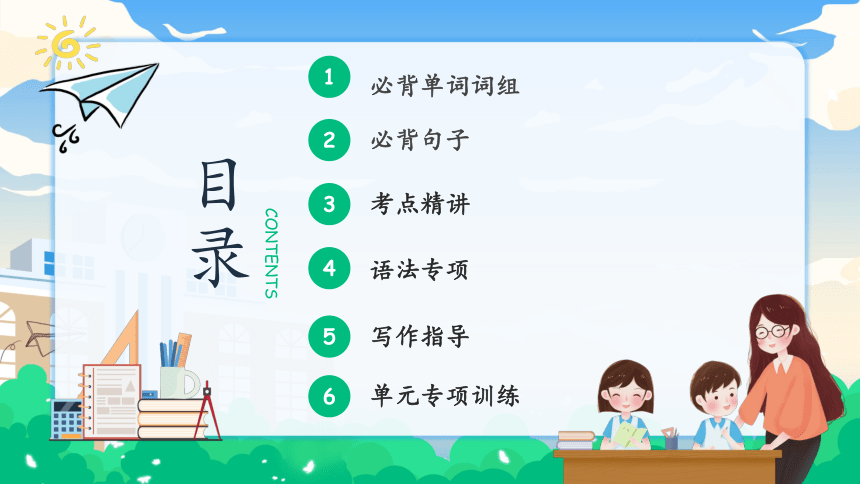

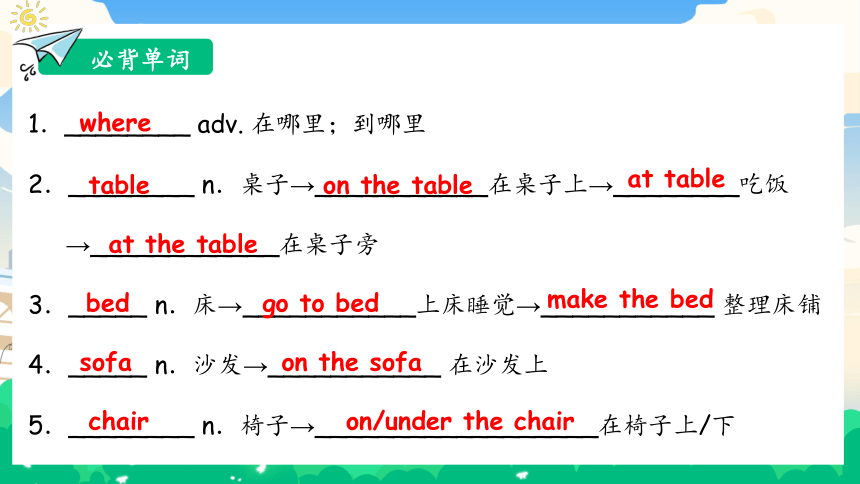
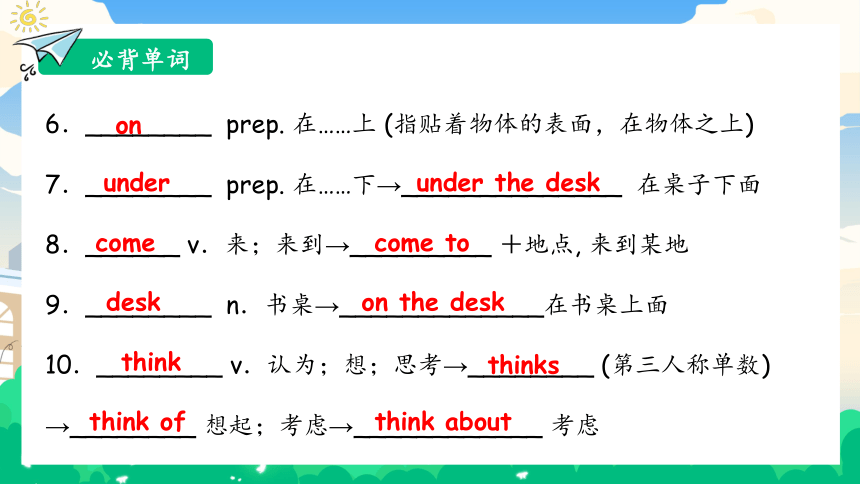
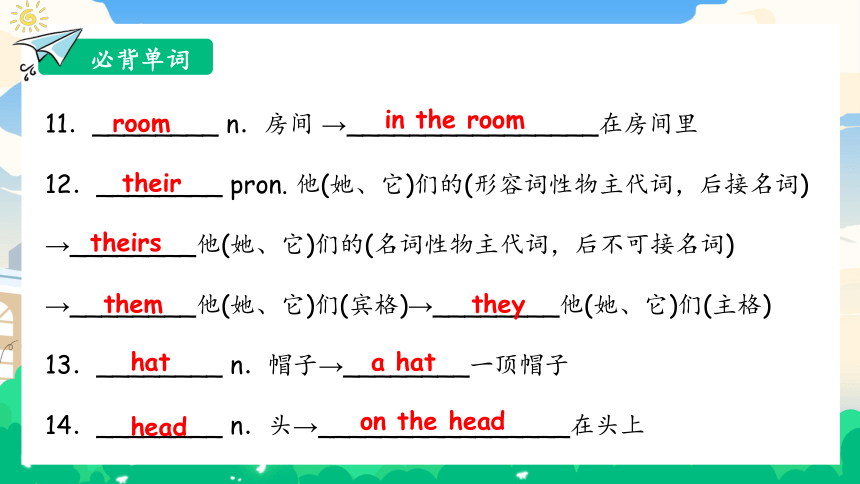
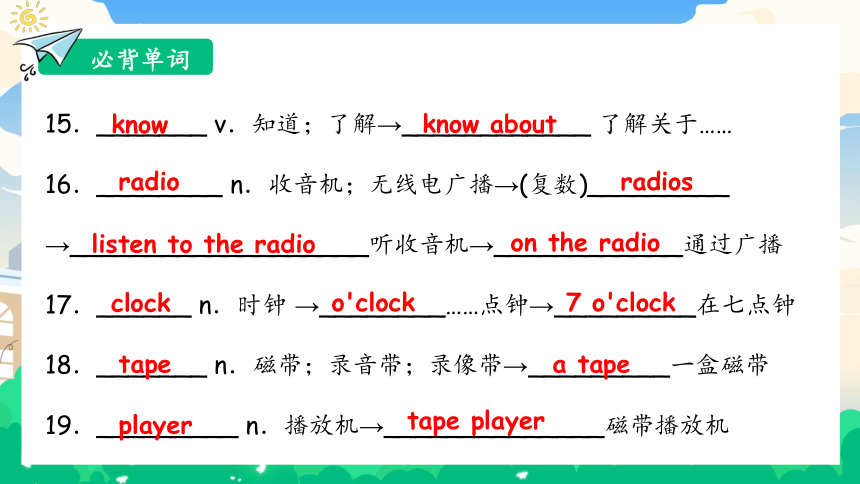

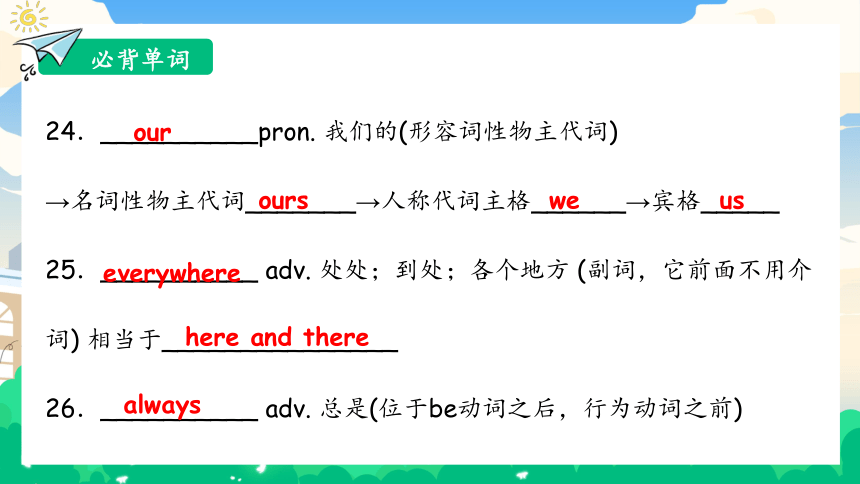
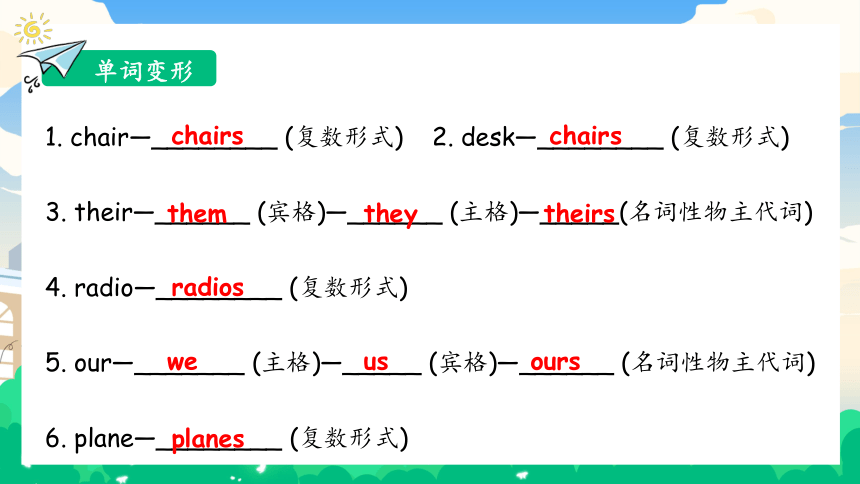
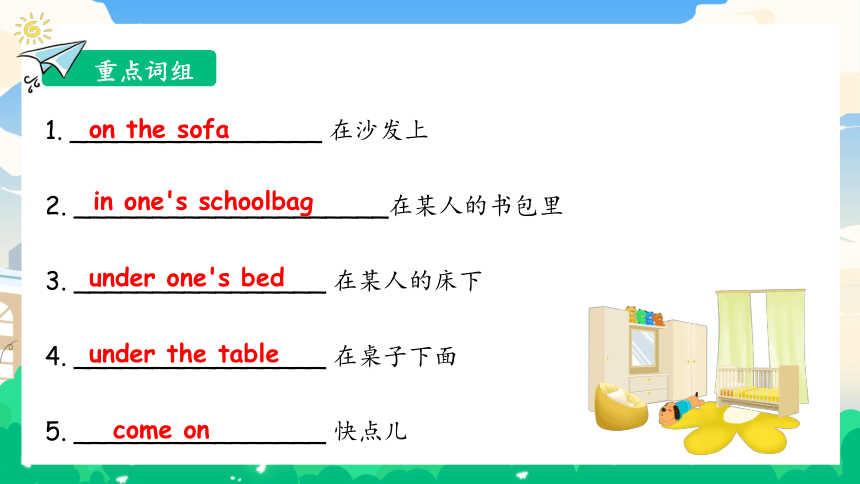

文档简介
(共168张PPT)
Where’s my schoolbag
Unit 4
主讲人:Cici老师
日期:2023年XX月
人教版七年级上册复习课件
目录
CONTENTS
必背单词词组
1
必背句子
2
考点精讲
3
语法专项
4
写作指导
5
单元专项训练
6
必背单词词组
必背单词/单词变形/必背词组
Part 1
必背单词
1.________ adv. 在哪里;到哪里
2.________ n.桌子→___________在桌子上→________吃饭
→____________在桌子旁
3._____ n.床→___________上床睡觉→___________ 整理床铺
4._____ n.沙发→___________ 在沙发上
5.________ n.椅子→__________________在椅子上/下
where
table
on the table
at table
at the table
bed
go to bed
make the bed
sofa
on the sofa
chair
on/under the chair
___
必背单词
6.________ prep. 在……上 (指贴着物体的表面,在物体之上)
7.________ prep. 在……下→______________ 在桌子下面
8.______ v.来;来到→_________ +地点, 来到某地
9.________ n.书桌→_____________在书桌上面
10.________ v.认为;想;思考→________ (第三人称单数)
→________ 想起;考虑→____________ 考虑
on
under
under the desk
come
come to
desk
on the desk
think
thinks
think of
think about
必背单词
11.________ n.房间 →________________在房间里
12.________ pron. 他(她、它)们的(形容词性物主代词,后接名词)
→________他(她、它)们的(名词性物主代词,后不可接名词)
→________他(她、它)们(宾格)→________他(她、它)们(主格)
13.________ n.帽子→________一顶帽子
14.________ n.头→________________在头上
room
in the room
their
theirs
them
they
hat
a hat
head
on the head
必背单词
15._______ v.知道;了解→____________ 了解关于……
16.________ n.收音机;无线电广播→(复数)_________
→___________________听收音机→____________通过广播
17.______ n.时钟 →________……点钟→_________在七点钟
18._______ n.磁带;录音带;录像带→_________一盒磁带
19._________ n.播放机→______________磁带播放机
know
know about
radio
radios
listen to the radio
on the radio
clock
o'clock
7 o'clock
tape
a tape
player
tape player
必背单词
20.________ n.模型→____________飞机模型
21.________n.飞机 → ________乘飞机
→________________在飞机上
22.________ adj. 整洁的;井井有条的vt. 使整洁
→________________一个整洁的房间
23.____conj. 但是 (表示转折关系)→_____和;与(表示并列关系)
model
model plane
plane
by plane
on the plane
tidy
a tidy room
but
and
必背单词
24.__________pron. 我们的(形容词性物主代词)
→名词性物主代词_______→人称代词主格______→宾格_____
25.__________ adv. 处处;到处;各个地方 (副词,它前面不用介词) 相当于_______________
26.__________ adv. 总是(位于be动词之后,行为动词之前)
our
ours
we
us
everywhere
here and there
always
单词变形
1. chair—________ (复数形式) 2. desk—________ (复数形式)
3. their—______ (宾格)—______ (主格)—_____(名词性物主代词)
4. radio—________ (复数形式)
5. our—_______ (主格)—_____ (宾格)—______ (名词性物主代词)
6. plane—________ (复数形式)
chairs
chairs
them
they
theirs
radios
we
us
ours
planes
重点词组
1. ________________ 在沙发上
2. ____________________在某人的书包里
3. ________________ 在某人的床下
4. ________________ 在桌子下面
5. ________________ 快点儿
on the sofa
in one's schoolbag
under one's bed
under the table
come on
重点词组
6. ________________ 在椅子下面
7. ________________ 在某人的房间里
8. ________________ 在某人头上
9. ________________ 磁带播放机
10. ________________ 飞机模型
under the chair
in one's room
on one's head
tape player
model plane
重点词组
11. ________________ 在收音机下面
12. ________________ 在书柜里
13. ________________ 铅笔盒
14. ________________ 在书桌下面
under the radio
in the bookcase
pencil box
under the desk
必背句型
Part 2
必背句型
1. ________ ________my books 我的书在哪里?
2. ____________ on the sofa. 它们在沙发上。
3. ________ ________, Jack! 快点儿,杰克!
4. And_____ _____ under the chair. 并且它不在椅子下面。
5. _____ ______ it's ______ your grandparents' _______.
我认为它在你祖父母的房间里。
Where are
They are
Come on
it’s not
I think in room
必背句型
6. ________ ________ ________. 我不知道。
7. Hi,Mom. Could you ________ some things to school for me
喂,妈妈。你能给我带些东西到学校来吗?
8. I'm ________, ________ Gina is not.
我很整洁,但吉娜却不。
9. ________ ________ ________ ________. 我有一个时钟。
I don't know
bring
tidy but
I have a clock
必背句型
10. Gina's books are ___________—on her bed, on the sofa and under the chair.
吉娜的书到处都是——在她的床上,在沙发上,在椅子下。
11. Gina ________ ________.
吉娜总是问。
12. The tape player ____ ____ ____ _________ _______.
磁带播放机在讲桌上。
everywhere
always asks
is on the teacher's desk
考点精讲
考点精讲+典型例题
Part 3
考点1:询问某人或某物位置的句型
Where are my books
句法分析
本句是由 where 引导的特殊疑问句,
其结构为“Where + is / are + 主语 ”用于询问某人或某物的位置。
疑问副词
be动词
主语
考点1:询问某人或某物位置的句型
e.g.--Where is the ruler 尺子在哪里
--It's on the desk.它在书桌上。
--Where are the chairs 椅子在哪里
--They're in the room.它们在房间里。
也可回答
In the room.
考点1:询问某人或某物位置的句型
“Where + is / are + 主语 ”
物品是单数,be动词用is,答语为: It's+介词短语.
物品是复数,be动词用are,答语为:They're+介词短语.
温馨提示:
① where is可缩写为where’s, where 和are 在正规英语中不缩写。
② 回答时可省略主语和be动词,直接回答地点。
③ 如果不知道在哪里,可回答“Sorry,I don’t know.”。
1.--________is Xiong'an New Area(雄安新区)
--It's in Hebei Province(省).
A.What B.Which C.When D.Where
2.-- ______ shall we meet for the picnic
--At the school gate.
A. How B. When C. Why D. Where
典型例题--单项选择
D
D
考点2:介词短语on的用法
They're on the sofa.
on 常构成介词短语,表示位置关系,强调一物在另一物的表面上,并且有接触。
结构为“介词on+the/ 形容词性物主代词/ 名词所有格+ 地点”。
拓展:其他介词的用法
around 围绕
up 向上
down 向下
into 进入
out of 出来
onto 上去
拓展:其他介词的用法
through 穿过(从中间)
across穿过(从表面)
along 沿着
away 远离
at 朝向
off脱离
拓展:其他介词的用法
on 在上面(接触)
over 在上面
(不接触,垂直)
above在上面
(不强调方向)
in 在里面
between 在中间
next to/near/beside/by
挨着
in 在里面
through 从内部穿过
across 从表面穿过
along 沿着
out of 出来
into 进入
under 在下方
below在斜下方
on 在上面
away 离开
over 在上方
above 在斜上方
1.--Excuse me, is there a computer room in your school
--Yes.It's________the fifth floor
A.on B.in C.at D.to
典型例题--单项选择
A
【点拨】句意为“--劳驾,请问你们学校有电脑室吗
--有的,它在五楼”。 on the fifth floor 在五楼。
2.There is a new TV ______ the wall.
A. at B. of C. on
典型例题--单项选择
C
【点拨】表示“在墙上”用on the wall。
考点3:under:在...下
It’s under the table.
under 此处用作介词,表示一个物体在另一个物体的下面,可以接触也可以不接触。
My cat is under the chair.
我的猫在椅子下面。
The shoes are________(在...下面) the bed.
典型例题--根据汉语提示完成句子。
under
考点4:table /'te bl/ n. 桌子
辨析:table 与desk
table 一般指没有抽屉的桌子,通常指“圆桌;餐桌”等,用于用餐、会谈或消遣等。
desk 一般指有抽屉的桌子,通常指“书桌;课桌”,用于读书、办公等。
e.g. I use a table to eat meals and I use a desk to study.
我用餐桌吃饭,用书桌学习。
考点4:table /'te bl/ n. 桌子
table 的常见搭配:
① at table 吃饭
② at the table 在桌子旁
③ set the table 摆餐具
④ clean the table 清理餐桌
考点5:Come on! 快点儿! 加油!
Come on! 的具体用法:
表示催促,意为 “赶快, 快点儿”
Come on, David! We’re late. 快点儿,戴维!我们迟到了。
表示鼓励,意为“加油”
Come on! You can do it ! 加油!你能做到的!
Come on, Jack!
考点5:Come on! 快点儿! 加油!
拓展:Come on! 还有“来;过来”之意,用于招呼别人。
e.g. Come on! Follow me! 过来!跟着我!
温馨提示:
come 后不能直接跟宾语,跟宾语时要加相应的介词。
但是当其后跟here, home 等副词时,不用加介词。
—Dad, we’ll play against a strong team in tomorrow’s football match.
—______! Just try your best!
A. Good idea B. Come on C. Thank you D. Wait a minute
典型例题--单项选择
B
【点拨】用语境分析法解题。Good idea 好主意;Come on 加油;Thank you 谢谢你;Wait a minute 等一会儿。由答语后句“Just try your best!”可知,此处应是加油、鼓励的话,故Come on 符合语境。
--Dad, I'm afraid it's too hard !
--______You can do it.
A.Well done B. Come on C.Thanks D.You're welcome
典型例题--单项选择
B
【点拨】考查交际用语。句意为“--爸爸,恐怕它太难了。--加油!你能做好的”。Well done 干得好,干得漂亮;Come on加油;Thanks 谢谢; You're welcome不用谢。根据句意,可知此处应为come on,表示“加油”。
考点6:come /k m/ v. 来;来到
come 用作不及物动词,意为“来;来到”,其对应词是go(去)。常与介词 to 搭配使用,后跟地点名词表示来到某地。
Please come to my house. 请来我家。Come here! 到这儿来!
名词短语
副词
考点7:I think+ 从句 我认为……
“I think +(that)从句”是一个含有宾语从句的复合句, 意思是“ 我认为……”,用于表明自己的想法或对某事的看法。句中用来引导宾语从句的连接词that 常可省略。
e.g. I think (that) she is a good student.
我认为她是一个好学生。
考点7:I think+ 从句 我认为……
拓展:在“I think + 宾语从句”的结构中,当宾语从句表示否定含义时,要把否定的形式转移到主句上,否定的意义放在从句上,即“I don’t think + 宾语从句”,意为“我认为……不……”。这种情况叫“否定前移”。
e.g. I don’t think it’s in your grandparents’ room.
我认为它不在你祖父母的房间里。
I think Jack is in the classroom.(改为否定句)
I _______ _______ _______ _______ in the classroom.
典型例题--按要求完成句子
don’t think Jack is
I_______think you_______right.
A.am,aren’t B.don’t,are
C.don’t,aren’t D.am not,are
典型例题--单项选择
B
考点8:think /θ k/ v. 认为;想;思考
e.g. I think it’s time to go to bed. 我想该睡觉了。
What do you think of the show so far
到目前为止你觉得这场演出怎么样?
I need time to think about it. 我需要时间考虑一下。
think 的常用短语:
① think of 想起 ② think about 考虑
考点8:think /θ k/ v. 认为;想;思考
I think so.
意为“我认为是这样”,
表示同意对方的观点或看法
I don’t think so.
意为“ 我认为不是这样的”
表示不同意对方的观点或看法
考点9:in / n/ prep. 在……里
考点1:“in+ 地点”表示“在……里”。
e.g. What’s in the room 房间里有什么?
考点2:“in + 时间(年、月、周、季节)”
e.g. There are seven days in a week. 一周有七天。
1.Look! The fish is swimming fast ______ the river.
A. at B. in C. of D. by
2.Father’s Day comes ______ June every year.
A. in B. on C. at D. to
典型例题--单项选择
B
A
考点10:room /ru m /n. 房间
room 可数名词,意为“房间”,复数形式是rooms。表达“在房间里”用in the room。
e.g. There are three rooms in my house. 我家有三个房间。
Your book isn’t in the room. 你的书不在房间里。
拓展:room 作“空间”讲时为不可数名词。make room for... 意为“给……腾地方”。
e.g. There is no room in the room. 这个房间里没有空间了。
考点10:room /ru m /n. 房间
由room 构成的单词或短语:
① classroom 教室 ② bedroom 卧室
③ washroom 洗手间 ④ reading room 阅览室
⑤ music room 音乐室
考点11:their / e (r)/, / er/ pron. 他(她、它)们的
their 用作形容词性物主代词,不可单独使用,后面需要接名词。
e.g. These are their books and those aren’t theirs.
这些是他们的书,那些不是他们的。
考点11:their / e (r)/, / er/ pron. 他(她、它)们的
their 的相关词:
their their 形容词性物主代词,他(她、它)们的
they 人称代词主格, 他(她,它)们
them 人称代词宾格, 他(她、它)们
theirs 名词性物主代词, 他(她、它)们的
1.On Teachers’ Day, students usually make cards
to thank _________ (they) teachers.
典型例题--用单词的适当形式填空。
【点拨】用语法判定法解题。分析句子结构可知,空格处需要一个定语,修饰后面的名词teachers,故填they 的形容词性物主代词形式their。
their
2.These two boys enjoy reading. They are talking about ________
favorite writers.
A. they B. them
C. their D. theirs
典型例题--单项选择。
C
考点12:省略句--And my hat
And my hat
这是一个省略句,完整形式为“And where is my hat ”。
在英语口语中,为了使表达简洁明了,在不引起歧义的情况下,可根据语境省去与上文相同的内容,并用and 连接。
e.g. —My pen is in the pencil box. 我的钢笔在铅笔盒里。
—And your eraser 那你的橡皮呢?
考点13:head/hed/ n. 头
on one’s head 意为“在某人的头上”,还可意为“由某人的头支撑着”。其中head 用作可数名词,意为“头”。
e.g. A nice flower is on the little girl’s head.
小女孩的头上有一朵漂亮的花。
The boy can stand on his head.
这个男孩可以头顶地站着。
考点13:head/hed/ n. 头
拓展:head 还有“负责人;领导人”之意。 the head of... 意为“……的领导人”。
e.g. Mr. Wang is the head of the school.
王先生是这所学校的校长。
谚语记单词
Two heads are better than one. 两人智慧胜一人。
考点14:I don’t know. 我不知道。
常用来表示对他人的询问或提出的问题不清楚或不知道。
e.g. —Where’s my hat 我的帽子在哪里?
—Sorry, I don’t know. 对不起,我不知道。
温馨提示:
日常交际中,通常在句子前面加“Sorry.”/ “I’m sorry.” 表示礼貌。
拓展:英语中含有行为动词的一般现在时的肯定句变否定句时常借助don’t 或doesn’t。主语是第三人称单数时用doesn’t; 主语是其他人称时用don’t,助动词后的行为动词要用原形。
e.g.肯定句:We have a library. 我们有一个图书馆。
否定句:We don’t have a library. 我们没有图书馆。
肯定句:He knows my name. 他知道我的名字。
否定句:He doesn’t know my name. 他不知道我的名字。
don’t=do not ; doesn’t=does not
1.—Excuse me, where is the Moonlight Hotel
— ______. I’m a stranger (陌生人) myself (我自己).
A. Sorry, I don’t know B. No, I don’t think so
C. It doesn’t matter D. Thank you all the same
典型例题--单项选择。
A
We come here at 10:00.(改为否定句)
We _______ _______ here at 10:00.
典型例题--按要求完成句子。
don’t come
【点拨】用语法判定法来解题。原句是含有行为动词的句子,且主语We 为第一人称复数,故用don’t 帮助构成否定,且谓语动词come 用原形。
考点15:know/n / v. 知道;了解
know 作实义动词,后常接名词或代词作宾语。
e.g. I know the answer to the question.我知道这个问题的答案。
Do you know about my school 你知道我学校的相关情况吗?
know 还可用作不及物 动词。know about 意为 “知道;了解”。
—Do you ______ his name
—Yes. His name is George.
A. see B. think C. spell D. know
典型例题--单项选择。
D
考点16:radio/'re di / n. 收音机;无线电广播
radio 用作可数名词,其复数形式是radios。
e.g. Please turn on the radio. 请打开收音机。
I see two radios in the room. 在房间里我看到两台收音机。
拓展:有些以-o 结尾的名词在变为复数时直接在词尾加-s,
photo( 照片),piano( 钢琴),zoo( 动物园),
bamboo(竹子),kangaroo(袋鼠)等。
考点16:radio/'re di / n. 收音机;无线电广播
有关radio 的短语:
① on the radio 通过无线电广播;通过收音机
② listen to the radio 听广播
③ radio station 广播电台
④ radio program 广播节目
考点16:radio/'re di / n. 收音机;无线电广播
魔法记忆
以-o 结尾变复数形式应加-s 的名词:
袋鼠(kangaroo)在动物园(zoo)里
一边观看竹子(bamboo)的照片(photo),
一边聆听收音机(radio)里的钢琴声(piano)。
考点17:player/'ple (r)/ n. 播放机
player 用作可数名词,由“play ( 播放) + er”构成,
复数形式为players。
e.g. I have two players. 我有两台播放机。
考点17:player/'ple (r)/ n. 播放机
拓展:
(1)player 用作可数名词,还可意为“参赛选手;运动员”。
e.g. Lucy and Lily are both players. 露西和莉莉都是运动员。
(2)play 用作动词,意为“打/ 踢(球);弹奏(乐曲;乐器等)”
e.g. Let’s play soccer after school. 放学后我们踢足球吧。
What about playing the tape player 播放磁带播放机怎么样
考点17:player/'ple (r)/ n. 播放机
运动员
播放机
player
考点18:plane /ple n/ n. 飞机
作可数名词,意为“飞机”。on a plane 意为“在飞机上”;by plane 意为“乘飞机”。
e.g. Can you see the plane over our heads
你能看到我们头顶上的飞机吗?
You can go to Shanghai by plane.
你可以乘飞机去上海。
考点18:plane /ple n/ n. 飞机
其他交通工具:
① bike 自行车 ② car 小汽车
③ bus 公共汽车 ④ train 火车
⑤ plane 飞机
考点19:bring/brm/v.带来;拿来
e.g. Bring me two books, please.请带给我两本书。
Don't bring friends from other schools.
不要带其他学校的朋友来。
bring
带来
take
拿走
考点19:bring/brm/v.带来;拿来
辨析: bring,take 与 bring
bring 带来;拿来”指把某物或某人从别处带到说话者所在之处,动作由远及近。
take 带去;带走;拿去”,指把某物或某人从说话者所在的地方带到其他地方
get “去取(或带来)”,指去把某物或某人带到说话者所在的地方,指去了又回来。
考点20:tidy /'ta di/ adj. 整洁的;井井有条的
作形容词,既可放在系动词后作表语,也可放在名词前作定语。
反义词为: untidy
e.g. Our classroom is tidy. 我们的教室是整洁的。
It’s a tidy room. 它是一个整洁的房间。
作表语
作定语
考点20:tidy /'ta di/ adj. 整洁的;井井有条的
拓展:tidy 也可作动词,后接宾语。tidy up 意为“收拾;整理”
e.g. Tidy up your room, please. 请整理你的房间。
tidy 的常用搭配:
① keep tidy 保持整洁
② tidy up 整理
考点20:tidy /'ta di/ adj. 整洁的;井井有条的
The little boy is always keeping his bedroom
clean and t ( 整齐的).
典型例题--根据汉语写出单词。
idy
考点21:but /b t; b t/ conj. 但是
辨析:but, and 与or
but 表示转折的逻辑关系或两种情况的对比,意为“但是;然而”。
and 连接两个或几个并列的成分,表示并列或顺承,常用于肯定句,表示“和;与”。and 连接的并列成分作主语时,谓语动词用复数形式。
or 在否定句中,连接并列成分用or 不用and,意为“也不”;or表示选择关系时,常用于选择疑问句,意为“或,还是”。
考点21:but /b t; b t/ conj. 但是
e.g. Our room is small, but it’s very tidy.
我们的房间小,但是很整洁。
He can play the guitar and he can sing, too.
他会弹吉他,并且也会唱歌。
Are you coming or not 你来还是不来?
but 为并列连词, 连接两个并列成分, 表示转折关系。
魔法记忆
but“但是”表转折, and 和or 表并列;
肯定句中用and, 否定句中or 替换。
1.I haven’t got any apple juice, _____ I’ve got some orange
juice. Would you like some
A. but B. and C. or D. for
典型例题--单项选择。
【点拨】前面“我没有苹果汁”与后面“我有一些橙汁”是转折
关系。
A
2.—Mary doesn’t like fish ______ chicken.
— Ben doesn’t like fish, ______ he likes chicken very much.
A. and; but B. or; but C. or; and D. and; or
典型例题--单项选择。
【点拨】用语法判定法及语境分析法解题。连词and 常用于肯定句,or 常用于否定句,but 常用于表示转折的句子中。第一个空所在的句子是否定句,要用or;第二个空所在句子前后表示转折关系,即“本不喜欢鱼肉,但是他非常喜欢鸡肉”,要用but 连接两个句子。
A
考点22:our /ɑ (r), 'a (r)/ pron. 我们的
our 用作形容词性物主代词,意为“我们的”,作定语,其后接名词。
e.g. We showed them some of our photos.
我们给他们看了我们的一些照片。
We have some books. 我们有些书。
These books are for us. 这些书是给我们的。
These books are ours. 这些书是我们的。
考点22:our /ɑ (r), 'a (r)/ pron. 我们的
第一人称复数代词:
第一人称复数代词 we 人称代词主格, 作主语
us 人称代词宾格, 作宾语
our 形容词性物主代词,后面跟名词
ours 名词性物主代词
—Judy, is that boy with glasses _____ new classmate
— Yes. Let’s say hello to him.
A. we B. us C. ours D. our
典型例题--单项选择。
【点拨】用语法判定法解题。由空后的名词短语new
classmate 可知空处缺少定语,故填形容词性物主代词our。
D
考点23:everywhere /'evriwe (r)/ adv. 处处;到处;各个地方
everywhere 是every 和where 合成的副词,称作“合成词”,相当于here and there,不能与at, in, on, to 等介词连用。
e.g. His notebooks are everywhere. 他的笔记本到处都是。
It is a world of flowers in spring in Dongying. You can see
flowers ______.
A. here B. there C. somewhere D. everywhere
典型例题--单项选择。
【点拨】用语境分析法解题。由前句“东营的春天是一
个花的世界”可知下一句句意为“你可以到处看到花”。
D
考点24:主语+谓语”结构的句子
Gina always asks.
本句是一个“主语+谓语”结构的句子,主语是Gina,谓语asks,
always作副词修饰 asks。在一般现在时中,当句子的主语是第三人称单数,谓语动词是行为动词时动词后要加-s或-es,即要用动词的第三人称单数形式。
e.g. I can help. 我可以帮忙。
He spells“cup”. 他拼写“cup”。
考点25:always /' lwe z/ adv. 总是
always 用作频度副词,表示频率,在句中作状语,位于be 动词、情态动词及助动词之后,实义动词之前。
温馨提示:
对always 进行提问要用 how often ( 多久一次)。
考点25:always /' lwe z/ adv. 总是
e.g. She is always in her room.
她总是在她的房间里。
Jack always likes playing soccer.
杰克总是喜欢踢足球。
表示频率的单词:
always 总是 usually 通常 often 时常
sometimes 有时 seldom 很少 never 从不
be 动词之后
实义动词之前
频度副词:表示动作发生的次数,频率的副词叫做频度副词。
频度副词
always 总是 100%
often 经常 60%
hardly ever= seldom 10%
never 从不 0%
usually 通常 80%
高
低
sometimes 30%
考点25:always /' lwe z/ adv. 总是
拓展:always 也可表示“一直”、“( 将) 永远;老是”等含义,
“be always doing sth.”意为“总是/ 一直做某事”,带有一定的感
彩(如不满、责备、赞赏等)。
e.g. I’ll always love you. 我将永远爱你。
The boy is always asking some silly questions.
那个男孩老是问一些愚蠢的问题。
—Where shall we eat tonight
—Let’s call Jack. He ______ knows the best places to go.
A. seldom B. always C. only
典型例题--单项选择。
B
典型例题--单项选择。
Please be polite(有礼貌的)and _____ offer(提供)your
seat to people who need it.
A. never B. seldom C. sometimes D. always
D
【点拨】never 从不;seldom 很少;sometimes 有时;
always 总是。结合前面的“请有礼貌”可知,always 符合语境,即“要总是给有需要的人让座”。
考点26:ask的用法
e.g. I ask my father to help me. 我请求爸爸帮助我。
He asks me about Wu Yifan.
他问我有关吴亦凡的事。
You can ask your parents for help.
你可以向父母求助。
考点26:ask的用法
典型例题--单项选择。
He always_____ (ask) his parents for some money(钱).
asks
【点拨】用语法判定法来解答。由句中的主语He可知是第三人称单数,故谓语动词用第三人称单数形式,ask加-s。
语法专项
Where 引导的特殊疑问句
Part 4
Where 引导的特殊疑问句
where为疑问副词,询问“什么地方;在哪里;从哪里;向哪里”。由where 引导的问句属于特殊疑问句,回答时要具体作答,不能用yes 或no 直接回答。
考点1:询问物品所在的位置的句型
询问物品所在的位置用where,
① 询问单数物品的位置句型:“Where is... ”,
答语:“It is in/ on/under...”;
② 询问复数物品的位置句型:“Where are... ”,
答语:“They are in/on/under...".
Where 引导的特殊疑问句
单数
结构: Where + is + 主语(第三人称单数)?
答语: It/He/She is + 介词短语.
e.g. —Where is your mother 你妈妈在哪里?
—She is in her room. 她在她的房间里。
考点1:询问物品所在的位置的句型
Where 引导的特殊疑问句
复数
结构: Where + are + 主语( 复数)
答语: They/We are + 介词短语.
e.g. —Where are your books 你的书在哪里?
—They are on my desk. 它们在我的书桌上。
考点1:询问物品所在的位置的句型
易错点提示:
① where后面的系动词be与主语的单复数保持一致。
② where is可以缩略为where's。
③ where引导的特殊疑问句,也可直接用介词短语回答。
考点1:询问物品所在的位置的句型
考点2:表达方位的介词
询问地点、位置用where 提问,在回答时应使用表达方位的介词,
表达方位的介词(短语)有:in 在…里;on 在…上;under 在…下
near 在……附近;next to 紧挨着……;behind 在……后面;
in front of 在……前面;beside 在……旁边;
between... and... 在……和……之间等。
典型例题--单项选择。
—Oh! ______is Wang Hui now The football match is starting.
— He may be in the library. He often reads at this time.
A.Where B.What C.When
A
【点拨】用关键词法解题。由答语中“He may be in the library.(他可能在图书馆里。)”可知询问地点,故用where 进行提问。
典型例题--对划线部分进行提问。
His grandparents live in Shanghai.(对画线部分提问)
______ ______ his grandparents live
Where is
【点拨】对地点进行提问要用where。句中有实义动词live,要借助于助动词do进行提问。
语法专项
方位介词in, on, under
Part 4
方位介词in, on, under
in under on
表示方位的介词in, on, under 都是方位介词,通常与名词构成介词短语,指明物品所在的具体方位。
结构:方位介词+ 冠词a/an/the/ 形容词性物主代词+ 名词
考点1:on: “在……上”
on: 意为“在……上”,通常指一个物体在另一个物体上面。物体与物体表面有直接接触。
e.g. The cup is on the table. 杯子在桌子上。
拓展:在具体某一天,如节日、星期几或具体某一天的上午、下午、晚上也用on。
典型例题--单项选择。
Try this dress on, Lucy. It must look nice _____ you.
A. on B. in C. at D. with
A
【点拨】结合前句“露西,试试这条裙子。”可知,此处指“它穿在你身上一定很好看”,故填on。
典型例题--单项选择。
We’re glad to see that Shenzhou-15 rose into the sky (升入太
空) ________ Nov. 29.
A. in B. at C. on D. to
C
考点2:in:“在……里面”
in:意为“在……里面”,指某物在另一物体的内部。
e.g. in the room 在房间里 in the box 在盒子里
拓展:in 还有“用某种语言”之意;还可表示时间,用在一年四季、月份前,以及早上、下午、晚上前。
e.g. Please say it in Chinese. 请用汉语说它。
I go to school in the morning. 我早上去上学。
典型例题--单项选择。
Teacher’s Day is _____ September.
A. in B.on C. at
A
【点拨】词义辨析法。in表示时间,用在一年四季、月份前,以及早上、下午、晚上前;at 表示时间,用于具体的时间点前;on表示时间,用于具体某一天前。句意为“教师节在九月十号”。September10 为具体的日期,所以前面用介词 on。
典型例题--单项选择。
We planted some flowers ________ the garden yesterday.
A. on B. to C. in D. of
C
【点拨】表示“在树上”时,如果某物(花、叶、果等) 长在树
上用介词on;外来物体在树上用介词in。
考点2:under,“在……下”
under: 意为“在……下”,指某物在另一物的正下方。两物可以接触也可不接触,或一物被另一物覆盖。
e.g. My shoes are under the bed.
我的鞋在床下面。
典型例题--单项选择。
1.—My book isn’t on the desk.
—Look! It’s ______ the desk.
A. on B. of C. for D. under
2.—A model plane is the tree. Let’s get it down.
— Look! The apples ________ the tree are really red.
A. in; in B. on; in C. in; on
D
C
语法专项
单元语法专练
Part 4
任务一:用in,on,under,of或for填空(每词限用一次)。
1.—Where are my pens,Helen
—Are they______your pencil box
2.My computer is______my desk.
3.Bob's baseball is______the chair.
4.This is a set______keys.
5.Thanks_______your watch.I can know the time.
in
on
under
of
for
任务二:根据句意用恰当的介词填空
1.A bird (鸟) is_________a tree.
2. A picture is____the wall.
3.Your shoes (鞋)are________the bed.
4. Some apples are______the tree.
in
on
under
on
任务三:单项选择。
( )1.—Are your keys on_____chair
—Yes,they are.
A.an B.these C.the D./
( )2.—Jane,who's that girl
—Oh,I___her.She's Linda,Tom's cousin.
A.ask B.know C.find D.say
C
B
任务三:单项选择。
( )3.A map of China is__the wall of our classroom.
A.in B.on C.under D.with
( )4.—____are the keys
—They're on the sofa.
A.How B.What C.Where D.What color
B
C
任务三:单项选择。
( )5.—Where are my books
—They're__the chair,__the box.
A.on;on B.in;under C.in;in D.under;in
( )6. Jack's iPhone 15 is________his ID card.
A.in B.on C.of D.at
D
B
任务四:按要求完成句子。
1.My books are in the bookcase.(对画线部分提问)
________ ________ ________books
2.Her notebooks are on the table.(改为一般疑问句)
_____her notebooks_____ _____ _____
3.Where are those girls (用in the library回答)
________in the library.
Where are the
Are on the table
They are
任务四:按要求完成句子。
4.An English book is on the desk.(对画线部分提问)
________ ________on the desk
5.The quilt is on the bed.(对画线部分提问)
________ ________the quilt
6. Are the oranges on the table (作肯定回答)
Yes,________ ________.
What is
Where is
they are
任务五:用方框中所给单词的适当形式补全短文。
Come and see.This is Mike's ______.Its ______is A248.You
can see a bed,a bookcase,a chair and a desk ______it.
Oh,______ is under the bed It's a dog.There______some
English books and CDs inthe bookcase.A cup is ______ the
desk.
in,what,cup,be,think,on,room,number,too,where
room
number
in
What
are
on
任务五:用方框中所给单词的适当形式补全短文。
And some milk(牛奶)is in the ______Oh,______is his
baseball It's on the sofa.You can see a hat on the sofa,
______. The hat is black.I______his room is nice.
in,what,cup,be,think,on,room,number,too,where
cup
Where
too
think
写作指导
写作思路+满分范文
Part 5
单元话题
假设你是Alice,你有一个属于自己的温馨小屋。房间里摆设精致、整洁,充满着青春的色彩。请根据提示以My room 为题,写一篇60 词左右的英语短文介绍一下你的房间,要适当发挥。
内容提示:
1. 房间漂亮、整洁;
2. 有一个书柜,里面有字典和书;
单元话题
3. 书桌上有一个时钟和一些磁带播放机;
4. 椅子下面有一个篮球;
5. ……
My room
__________________________________________________________________________________________________________________________________________________________________________________________
审题指导
阅读写作内容及要求,可获得以下写作信息:
1. 房间的整体情况:漂亮、整洁;
2. 物品及其摆放位置,介绍时要注意方位介词in/on/under... 的正确使用;
3. 写作时,可按由远及近或由近及远的顺序进行描述。
写作方法
“总分总法”写物品陈设类作文
“总分总法”:①先整体介绍房间;
②然后分别介绍房间内的摆设;
③再总括所讲内容,表达自己的情感。
写作模板
“总分总法”写物品陈设类作文 总:开篇点题 This is... room. / Here is... / I have a... room.
分:物品摆设 In my room, my... are on / in / under the...
Where is / are...
总:表达情感 I like / love... room.
经典词句
单词 room, tidy, clock, desk, chair, where
短语 in my room, in the bookcase, on my desk, next to, under the chair, tape player
句子 ① This is my room. ② It’s nice and tidy.
③ Where is my pencil box ④ I love my room.
范文赏析
My room
This is my room. It’s nice and tidy. In my room, my dictionary and books are in the bookcase. A clock is on my desk. Some tape players are next to it. A basketball is under the chair. Where’s my pencil box It’s in the schoolbag. What’s in the pencil box There are some pens and pencils. I love my room.
名师点评
本文层次清晰、结构完整,运用了“总分总法”描述房间物品及其摆放位置。
第一: 总:(第1 ~ 2 句)“This is my room. It’s nice and tidy.”;分:(第3~10 句);总:(最后1 句) “I love my room.”。
第二:介词短语in my room, in the bookcase, on my desk, under the chair, in the schoolbag, in the pencil box 等的使用,准确介绍了物品的位置。
写作任务
假设你是Tom,请根据上面的图片提示简单介绍一下你的房间。
提示词:tidy整洁的;soccerball足球;plant植物
要求:语句通顺,内容完整,50词左右。
思路点拨--谋篇布局
①理清文章思路,构建文章结构。 Hello,everyone.I'm Tom.
②引出话题:This is my room.
③介绍自己房的间介绍物品的位置:A bed and a desk are in it.
My soccer ball is…/Some books and a plant are..
My schoolbag is…
④表达感受:I like my room very much.
思路点拨--巧妙衔接
①and为连词,在文中可以连接两个名词作并列主语,如句2.
中的“床”和“书桌”就可用and连接。
②在介绍物品的位置时,常用一些方位介词如on,in,under等充
当连接纽带。
满分范文
Hello,everyone.I'm Tom.This is my room.Abed and a desk are in it.My schoolbag is on the bed.Some books and a plant are on the desk.My soccer ball is under the desk.My parents think my room is tidy.I like my room very much.
单元专项训练
单元测评
Part 6
任务一:单项选择
1. This is ____ hat. ____ hat is Mary's.
A. a; The B. a; A C. the; A D. the; The
2. The baseball is ____ the table ____ the room.
A. on; under B. in; on
C. under; under D. under; in
A
D
任务一:单项选择
3. —Hi, Sally! Where are Tom ____ David
—Tom is in the classroom ____ David isn't.
A. and; but B. but; and C. but; but D. and; and
4. Kate's room isn't ____. Her books are everywhere.
A. busy B. bad C. long D. tidy
A
D
任务一:单项选择
5. — ____ is my baseball I can't find it.
—I think it's in your parents' room.
A. Where B. What C. When D. How
6. —Jane, who's that girl
—Oh, I ____ her. She's Kate.
A. know B. thank C. find D. meet
A
A
任务一:单项选择
7. —Where is my hat, Mom
—I ____ it's in your room.
A. have B. call C. ask D. think
8. [易错题]____ room is big and nice.
A. Kate's and Jane's B. Kate's and Jane
C. Kate and Jane D. Kate and Jane's
D
D
任务一:单项选择
9. —Is your book on the desk
—____. It's Li Ming's. The book in the schoolbag is ____.
A. Yes, it is; my B. Yes, it is; mine
C. No, it isn't; my D. No, it isn't; mine
10. —____, Jim! It's 7: 45 in the morning. You're late.
—Oh, no! I can't find my schoolbag, Mom. Where is it
A. Spell it B. Thank you
C. Come on D. Have a good day
D
C
任务二:完形填空
Hello, everyone! Do you know me 1.____ name's Dale Smith.
Look!Here is 2.____ photo 3.____ my room. You can see a bed,
a table 4.____ a bookcase in it. Some books 5.____ in the
bookcase.
( )1. A. My B. Her C. His D. Your
( )2. A. / B. a C. an D. some
( )3. A. to B. in C. on D. оf
( )4. A. but B. and C. so D. or
( )5. A. is B. are C. be D. am
A
B
D
B
B
任务二:完形填空
Can you 6.____ my computer?It's on the table. And my tape
player is 7.____ the table, too. Look!What's that 8.____
my pencil box.
( )6. A. see B. ask C. call D. need
( )7. A. in B. under C. behind(在后面) D. on
( )8. A. It B. They C. It's D. They're
A
D
C
任务二:完形填空
It's beside(在……旁边) the bed. Where is my model plane?Oh,
it's 9.____ my hand. I think my 10.____ is very nice. I really
love to live(居住) in it.
( )9. A. at B. to C. under D. in
( )10. A. book B. room C. tape D. table
D
B
任务三:阅读理解(A)
1. The ID card belongs to(属于)___.
A. Helen B. Paul
C. David D. John
2. ____is (are) white.
A. The hat
B. The ID card and the watch
C. The radio
D. The model plane and the radio
A
B
任务三:阅读理解(A)
3. Where is the model plane
A. In the schoolbag. B. On the sofa.
C. On the bookcase. D. Under the bed.
4. Who is Anna
A. Sally's brother. B. Linda's cousin.
C. Tom's aunt. D. Jane's friend.
D
C
任务三:阅读理解(A)
5. Which of the following is true
A. Tom's hat is red.
B. The ID card is on the chair.
C. The radio is John's.
D. Sally is David's sister.
C
任务三:阅读理解(B)
The dog family is in a nice house. The house is tidy, but
Brother Dog and Sister Dog's room is not. The pens, books,
and models are everywhere in their blue room.
“We need some boxes! They are for your pens, books and
models,” says Dad.
“That's good!” says Mom.
任务三:阅读理解(B)
Dad makes three boxes. And they find three boxes, too.
Brother Dog and Sister Dog must put pens, books and models
in these boxes. Oh! They ask Mom for help.
It's OK now. “Wow!” Brother Dog and Sister Dog say. “It
is a good and tidy room!”
任务三:阅读理解(B)
1. Where is the dog family
A. In a classroom. B. Under a sofa.
C. In a house. D. On a plane.
2. What color is Brother Dog and Sister Dog's room
A. Blue. B. Green. C. White. D. Yellow.
3. The Chinese meaning of the underlined word “makes”is ____.
A. 制作 B. 绘画 C. 毁坏 D. 偷盗
C
A
A
任务三:阅读理解(B)
4. Who put pens, books and models in these boxes
A. Dad and Mom.
B. Sister Dog and Dad.
C. The grandparents.
D. Brother Dog, Sister Dog and Mom.
5. ____ dogs are in the family.
A. Three B. Four C. Five D. Six
D
B
任务三:阅读理解(C)
Jerry gets up very early today and finds something changes(改
变) in his house. But he can't tell why. He carefully looks around
the house and finds:
A green plant is in the kitchen.
Some beautiful flowers are on the table.
The dog house in the corner of the yard is gone.
The green clock in his bedroom changes into a yellow one.
任务三:阅读理解(C)
“Mum! Mum! An alien(外星人) changes our house!” Jerry is
very surprised. He runs to his mum and tells her about what he
sees. Mum is cleaning the living room. She is not surprised at all.
“Oh, it's your dad. He thinks our house is too boring(无聊的), so
he wants to have a change. What do you think of the changes Do
you like them?”
任务三:阅读理解(C)
1. How many changes does Jerry find
A. Three. B. Four. C. Five. D. Six.
2. Where are the flowers
A. They are on the sofa. B. They are on the table.
C. They are in the garden. D. They are in the kitchen.
B
B
任务三:阅读理解(C)
3. Why does Jerry's father want to have a change
A. Because an alien asks him to do so.
B. Because he has a lot of money this year.
C. Because he thinks the house is too boring.
D. Because Jerry's mother doesn't like the house.
4. What does the underlined word “surprised” mean(意思是) in
Chinese
A. 惊讶的 B. 生气的 C. 快乐的 D. 无聊的
C
A
任务三:阅读理解(C)
5. What's the best title(标题) for the passage
A. A Story of an Alien
B. Jerry's Good Father
C. Changes in Jerry's House
D. A Happy Day
C
任务四:短文还原
A. My ID card number is 73982.
B. I sometimes(有时) play computer games on it.
C. It is in the bookcase.
D. Are my keys on the desk, too E. My books are in it.
F. I'm a teacher.
G. It's a blue jacket.
Hello! My name is Cindy. Here
is my room. My computer is on
the desk. 1. ________ My
jacket is on the bed. 2.
________ My ID card is on
the chair. 3. ________ Can
you see my schoolbag
B
G
A
任务四:短文还原
A. My ID card number is 73982.
B. I sometimes(有时) play computer games on it.
C. It is in the bookcase.
D. Are my keys on the desk, too E. My books are in it.
F. I'm a teacher.
G. It's a blue jacket.
It's under the chair. 4.
________ Where is
my clock
5. ________ I always go to
school on time(准时).
E
C
任务五:补全对话。
A. No, it isn't.
B. The CDs Oh, they're in the drawer(抽屉).
C. They're in his schoolbag.
D. And your hat is under the table,too.
E. It's on the sofa.
F. You are welcome.
A: Hi, John.
B: Yes
A: Is Tim's dictionary on the
table
B: 1. ________ It's on the
bed.
A
任务五:补全对话。
A. No, it isn't.
B. The CDs Oh, they're in the drawer(抽屉).
C. They're in his schoolbag.
D. And your hat is under the table,too.
E. It's on the sofa.
F. You are welcome.
A: Where are Tim's English
books Are they in the
bookcase
B: No, they aren't. 2.
________
A: Where is his pencil box
then
B: Look!3. ________
C
E
任务五:补全对话。
A. No, it isn't.
B. The CDs Oh, they're in the drawer(抽屉).
C. They're in his schoolbag.
D. And your hat is under the table,too.
E. It's on the sofa.
F. You are welcome.
A: And where's his tape
B: It's under the table. 4.
________
A: Oh, thanks. And where are
his CDs
B: 5. ________
A: Thank you.
D
B
任务六:根据句意及首字母提示完成句子。
1. They are my friends. ______(她们的) names are Alice and Kate.
2. A hat is on David's ________(头).
3. Can you see the baseball u________ the chair
4. The c________ says 8: 45. Oh, we're late for the first class.
5. Sally, your pens are e__________. Put them in your pencil box.
their
head
under
clock
everywhere
任务七:书面表达。
假设你是陈明,你刚搬进新家,你很开心有了属于自己的房间,并想
与你的QQ好友汤姆(Tom)一起分享这份快乐。上面是一张你房间的图
片,请你根据图片提示写一篇英语小短文,向汤姆介绍你的房间。
提示词: near 在……附近;door 门;like 喜欢
要求: 1. 文中不要出现所在学校的校名和师生姓名;
2. 词数60左右。
任务七:书面表达。
This is my room. A bed,a table and a chair are in it. My bed is
near the door. My quilt,my pillow and my schoolbag are on the
bed. Near the bed are the chair and the table. Two books,a pen
and a pencil are on the table. Oh,what is this It's my model
plane. It's on the chair. I like my room very much.
See You !
人教版四年级上册复习课件
Where’s my schoolbag
Unit 4
主讲人:Cici老师
日期:2023年XX月
人教版七年级上册复习课件
目录
CONTENTS
必背单词词组
1
必背句子
2
考点精讲
3
语法专项
4
写作指导
5
单元专项训练
6
必背单词词组
必背单词/单词变形/必背词组
Part 1
必背单词
1.________ adv. 在哪里;到哪里
2.________ n.桌子→___________在桌子上→________吃饭
→____________在桌子旁
3._____ n.床→___________上床睡觉→___________ 整理床铺
4._____ n.沙发→___________ 在沙发上
5.________ n.椅子→__________________在椅子上/下
where
table
on the table
at table
at the table
bed
go to bed
make the bed
sofa
on the sofa
chair
on/under the chair
___
必背单词
6.________ prep. 在……上 (指贴着物体的表面,在物体之上)
7.________ prep. 在……下→______________ 在桌子下面
8.______ v.来;来到→_________ +地点, 来到某地
9.________ n.书桌→_____________在书桌上面
10.________ v.认为;想;思考→________ (第三人称单数)
→________ 想起;考虑→____________ 考虑
on
under
under the desk
come
come to
desk
on the desk
think
thinks
think of
think about
必背单词
11.________ n.房间 →________________在房间里
12.________ pron. 他(她、它)们的(形容词性物主代词,后接名词)
→________他(她、它)们的(名词性物主代词,后不可接名词)
→________他(她、它)们(宾格)→________他(她、它)们(主格)
13.________ n.帽子→________一顶帽子
14.________ n.头→________________在头上
room
in the room
their
theirs
them
they
hat
a hat
head
on the head
必背单词
15._______ v.知道;了解→____________ 了解关于……
16.________ n.收音机;无线电广播→(复数)_________
→___________________听收音机→____________通过广播
17.______ n.时钟 →________……点钟→_________在七点钟
18._______ n.磁带;录音带;录像带→_________一盒磁带
19._________ n.播放机→______________磁带播放机
know
know about
radio
radios
listen to the radio
on the radio
clock
o'clock
7 o'clock
tape
a tape
player
tape player
必背单词
20.________ n.模型→____________飞机模型
21.________n.飞机 → ________乘飞机
→________________在飞机上
22.________ adj. 整洁的;井井有条的vt. 使整洁
→________________一个整洁的房间
23.____conj. 但是 (表示转折关系)→_____和;与(表示并列关系)
model
model plane
plane
by plane
on the plane
tidy
a tidy room
but
and
必背单词
24.__________pron. 我们的(形容词性物主代词)
→名词性物主代词_______→人称代词主格______→宾格_____
25.__________ adv. 处处;到处;各个地方 (副词,它前面不用介词) 相当于_______________
26.__________ adv. 总是(位于be动词之后,行为动词之前)
our
ours
we
us
everywhere
here and there
always
单词变形
1. chair—________ (复数形式) 2. desk—________ (复数形式)
3. their—______ (宾格)—______ (主格)—_____(名词性物主代词)
4. radio—________ (复数形式)
5. our—_______ (主格)—_____ (宾格)—______ (名词性物主代词)
6. plane—________ (复数形式)
chairs
chairs
them
they
theirs
radios
we
us
ours
planes
重点词组
1. ________________ 在沙发上
2. ____________________在某人的书包里
3. ________________ 在某人的床下
4. ________________ 在桌子下面
5. ________________ 快点儿
on the sofa
in one's schoolbag
under one's bed
under the table
come on
重点词组
6. ________________ 在椅子下面
7. ________________ 在某人的房间里
8. ________________ 在某人头上
9. ________________ 磁带播放机
10. ________________ 飞机模型
under the chair
in one's room
on one's head
tape player
model plane
重点词组
11. ________________ 在收音机下面
12. ________________ 在书柜里
13. ________________ 铅笔盒
14. ________________ 在书桌下面
under the radio
in the bookcase
pencil box
under the desk
必背句型
Part 2
必背句型
1. ________ ________my books 我的书在哪里?
2. ____________ on the sofa. 它们在沙发上。
3. ________ ________, Jack! 快点儿,杰克!
4. And_____ _____ under the chair. 并且它不在椅子下面。
5. _____ ______ it's ______ your grandparents' _______.
我认为它在你祖父母的房间里。
Where are
They are
Come on
it’s not
I think in room
必背句型
6. ________ ________ ________. 我不知道。
7. Hi,Mom. Could you ________ some things to school for me
喂,妈妈。你能给我带些东西到学校来吗?
8. I'm ________, ________ Gina is not.
我很整洁,但吉娜却不。
9. ________ ________ ________ ________. 我有一个时钟。
I don't know
bring
tidy but
I have a clock
必背句型
10. Gina's books are ___________—on her bed, on the sofa and under the chair.
吉娜的书到处都是——在她的床上,在沙发上,在椅子下。
11. Gina ________ ________.
吉娜总是问。
12. The tape player ____ ____ ____ _________ _______.
磁带播放机在讲桌上。
everywhere
always asks
is on the teacher's desk
考点精讲
考点精讲+典型例题
Part 3
考点1:询问某人或某物位置的句型
Where are my books
句法分析
本句是由 where 引导的特殊疑问句,
其结构为“Where + is / are + 主语 ”用于询问某人或某物的位置。
疑问副词
be动词
主语
考点1:询问某人或某物位置的句型
e.g.--Where is the ruler 尺子在哪里
--It's on the desk.它在书桌上。
--Where are the chairs 椅子在哪里
--They're in the room.它们在房间里。
也可回答
In the room.
考点1:询问某人或某物位置的句型
“Where + is / are + 主语 ”
物品是单数,be动词用is,答语为: It's+介词短语.
物品是复数,be动词用are,答语为:They're+介词短语.
温馨提示:
① where is可缩写为where’s, where 和are 在正规英语中不缩写。
② 回答时可省略主语和be动词,直接回答地点。
③ 如果不知道在哪里,可回答“Sorry,I don’t know.”。
1.--________is Xiong'an New Area(雄安新区)
--It's in Hebei Province(省).
A.What B.Which C.When D.Where
2.-- ______ shall we meet for the picnic
--At the school gate.
A. How B. When C. Why D. Where
典型例题--单项选择
D
D
考点2:介词短语on的用法
They're on the sofa.
on 常构成介词短语,表示位置关系,强调一物在另一物的表面上,并且有接触。
结构为“介词on+the/ 形容词性物主代词/ 名词所有格+ 地点”。
拓展:其他介词的用法
around 围绕
up 向上
down 向下
into 进入
out of 出来
onto 上去
拓展:其他介词的用法
through 穿过(从中间)
across穿过(从表面)
along 沿着
away 远离
at 朝向
off脱离
拓展:其他介词的用法
on 在上面(接触)
over 在上面
(不接触,垂直)
above在上面
(不强调方向)
in 在里面
between 在中间
next to/near/beside/by
挨着
in 在里面
through 从内部穿过
across 从表面穿过
along 沿着
out of 出来
into 进入
under 在下方
below在斜下方
on 在上面
away 离开
over 在上方
above 在斜上方
1.--Excuse me, is there a computer room in your school
--Yes.It's________the fifth floor
A.on B.in C.at D.to
典型例题--单项选择
A
【点拨】句意为“--劳驾,请问你们学校有电脑室吗
--有的,它在五楼”。 on the fifth floor 在五楼。
2.There is a new TV ______ the wall.
A. at B. of C. on
典型例题--单项选择
C
【点拨】表示“在墙上”用on the wall。
考点3:under:在...下
It’s under the table.
under 此处用作介词,表示一个物体在另一个物体的下面,可以接触也可以不接触。
My cat is under the chair.
我的猫在椅子下面。
The shoes are________(在...下面) the bed.
典型例题--根据汉语提示完成句子。
under
考点4:table /'te bl/ n. 桌子
辨析:table 与desk
table 一般指没有抽屉的桌子,通常指“圆桌;餐桌”等,用于用餐、会谈或消遣等。
desk 一般指有抽屉的桌子,通常指“书桌;课桌”,用于读书、办公等。
e.g. I use a table to eat meals and I use a desk to study.
我用餐桌吃饭,用书桌学习。
考点4:table /'te bl/ n. 桌子
table 的常见搭配:
① at table 吃饭
② at the table 在桌子旁
③ set the table 摆餐具
④ clean the table 清理餐桌
考点5:Come on! 快点儿! 加油!
Come on! 的具体用法:
表示催促,意为 “赶快, 快点儿”
Come on, David! We’re late. 快点儿,戴维!我们迟到了。
表示鼓励,意为“加油”
Come on! You can do it ! 加油!你能做到的!
Come on, Jack!
考点5:Come on! 快点儿! 加油!
拓展:Come on! 还有“来;过来”之意,用于招呼别人。
e.g. Come on! Follow me! 过来!跟着我!
温馨提示:
come 后不能直接跟宾语,跟宾语时要加相应的介词。
但是当其后跟here, home 等副词时,不用加介词。
—Dad, we’ll play against a strong team in tomorrow’s football match.
—______! Just try your best!
A. Good idea B. Come on C. Thank you D. Wait a minute
典型例题--单项选择
B
【点拨】用语境分析法解题。Good idea 好主意;Come on 加油;Thank you 谢谢你;Wait a minute 等一会儿。由答语后句“Just try your best!”可知,此处应是加油、鼓励的话,故Come on 符合语境。
--Dad, I'm afraid it's too hard !
--______You can do it.
A.Well done B. Come on C.Thanks D.You're welcome
典型例题--单项选择
B
【点拨】考查交际用语。句意为“--爸爸,恐怕它太难了。--加油!你能做好的”。Well done 干得好,干得漂亮;Come on加油;Thanks 谢谢; You're welcome不用谢。根据句意,可知此处应为come on,表示“加油”。
考点6:come /k m/ v. 来;来到
come 用作不及物动词,意为“来;来到”,其对应词是go(去)。常与介词 to 搭配使用,后跟地点名词表示来到某地。
Please come to my house. 请来我家。Come here! 到这儿来!
名词短语
副词
考点7:I think+ 从句 我认为……
“I think +(that)从句”是一个含有宾语从句的复合句, 意思是“ 我认为……”,用于表明自己的想法或对某事的看法。句中用来引导宾语从句的连接词that 常可省略。
e.g. I think (that) she is a good student.
我认为她是一个好学生。
考点7:I think+ 从句 我认为……
拓展:在“I think + 宾语从句”的结构中,当宾语从句表示否定含义时,要把否定的形式转移到主句上,否定的意义放在从句上,即“I don’t think + 宾语从句”,意为“我认为……不……”。这种情况叫“否定前移”。
e.g. I don’t think it’s in your grandparents’ room.
我认为它不在你祖父母的房间里。
I think Jack is in the classroom.(改为否定句)
I _______ _______ _______ _______ in the classroom.
典型例题--按要求完成句子
don’t think Jack is
I_______think you_______right.
A.am,aren’t B.don’t,are
C.don’t,aren’t D.am not,are
典型例题--单项选择
B
考点8:think /θ k/ v. 认为;想;思考
e.g. I think it’s time to go to bed. 我想该睡觉了。
What do you think of the show so far
到目前为止你觉得这场演出怎么样?
I need time to think about it. 我需要时间考虑一下。
think 的常用短语:
① think of 想起 ② think about 考虑
考点8:think /θ k/ v. 认为;想;思考
I think so.
意为“我认为是这样”,
表示同意对方的观点或看法
I don’t think so.
意为“ 我认为不是这样的”
表示不同意对方的观点或看法
考点9:in / n/ prep. 在……里
考点1:“in+ 地点”表示“在……里”。
e.g. What’s in the room 房间里有什么?
考点2:“in + 时间(年、月、周、季节)”
e.g. There are seven days in a week. 一周有七天。
1.Look! The fish is swimming fast ______ the river.
A. at B. in C. of D. by
2.Father’s Day comes ______ June every year.
A. in B. on C. at D. to
典型例题--单项选择
B
A
考点10:room /ru m /n. 房间
room 可数名词,意为“房间”,复数形式是rooms。表达“在房间里”用in the room。
e.g. There are three rooms in my house. 我家有三个房间。
Your book isn’t in the room. 你的书不在房间里。
拓展:room 作“空间”讲时为不可数名词。make room for... 意为“给……腾地方”。
e.g. There is no room in the room. 这个房间里没有空间了。
考点10:room /ru m /n. 房间
由room 构成的单词或短语:
① classroom 教室 ② bedroom 卧室
③ washroom 洗手间 ④ reading room 阅览室
⑤ music room 音乐室
考点11:their / e (r)/, / er/ pron. 他(她、它)们的
their 用作形容词性物主代词,不可单独使用,后面需要接名词。
e.g. These are their books and those aren’t theirs.
这些是他们的书,那些不是他们的。
考点11:their / e (r)/, / er/ pron. 他(她、它)们的
their 的相关词:
their their 形容词性物主代词,他(她、它)们的
they 人称代词主格, 他(她,它)们
them 人称代词宾格, 他(她、它)们
theirs 名词性物主代词, 他(她、它)们的
1.On Teachers’ Day, students usually make cards
to thank _________ (they) teachers.
典型例题--用单词的适当形式填空。
【点拨】用语法判定法解题。分析句子结构可知,空格处需要一个定语,修饰后面的名词teachers,故填they 的形容词性物主代词形式their。
their
2.These two boys enjoy reading. They are talking about ________
favorite writers.
A. they B. them
C. their D. theirs
典型例题--单项选择。
C
考点12:省略句--And my hat
And my hat
这是一个省略句,完整形式为“And where is my hat ”。
在英语口语中,为了使表达简洁明了,在不引起歧义的情况下,可根据语境省去与上文相同的内容,并用and 连接。
e.g. —My pen is in the pencil box. 我的钢笔在铅笔盒里。
—And your eraser 那你的橡皮呢?
考点13:head/hed/ n. 头
on one’s head 意为“在某人的头上”,还可意为“由某人的头支撑着”。其中head 用作可数名词,意为“头”。
e.g. A nice flower is on the little girl’s head.
小女孩的头上有一朵漂亮的花。
The boy can stand on his head.
这个男孩可以头顶地站着。
考点13:head/hed/ n. 头
拓展:head 还有“负责人;领导人”之意。 the head of... 意为“……的领导人”。
e.g. Mr. Wang is the head of the school.
王先生是这所学校的校长。
谚语记单词
Two heads are better than one. 两人智慧胜一人。
考点14:I don’t know. 我不知道。
常用来表示对他人的询问或提出的问题不清楚或不知道。
e.g. —Where’s my hat 我的帽子在哪里?
—Sorry, I don’t know. 对不起,我不知道。
温馨提示:
日常交际中,通常在句子前面加“Sorry.”/ “I’m sorry.” 表示礼貌。
拓展:英语中含有行为动词的一般现在时的肯定句变否定句时常借助don’t 或doesn’t。主语是第三人称单数时用doesn’t; 主语是其他人称时用don’t,助动词后的行为动词要用原形。
e.g.肯定句:We have a library. 我们有一个图书馆。
否定句:We don’t have a library. 我们没有图书馆。
肯定句:He knows my name. 他知道我的名字。
否定句:He doesn’t know my name. 他不知道我的名字。
don’t=do not ; doesn’t=does not
1.—Excuse me, where is the Moonlight Hotel
— ______. I’m a stranger (陌生人) myself (我自己).
A. Sorry, I don’t know B. No, I don’t think so
C. It doesn’t matter D. Thank you all the same
典型例题--单项选择。
A
We come here at 10:00.(改为否定句)
We _______ _______ here at 10:00.
典型例题--按要求完成句子。
don’t come
【点拨】用语法判定法来解题。原句是含有行为动词的句子,且主语We 为第一人称复数,故用don’t 帮助构成否定,且谓语动词come 用原形。
考点15:know/n / v. 知道;了解
know 作实义动词,后常接名词或代词作宾语。
e.g. I know the answer to the question.我知道这个问题的答案。
Do you know about my school 你知道我学校的相关情况吗?
know 还可用作不及物 动词。know about 意为 “知道;了解”。
—Do you ______ his name
—Yes. His name is George.
A. see B. think C. spell D. know
典型例题--单项选择。
D
考点16:radio/'re di / n. 收音机;无线电广播
radio 用作可数名词,其复数形式是radios。
e.g. Please turn on the radio. 请打开收音机。
I see two radios in the room. 在房间里我看到两台收音机。
拓展:有些以-o 结尾的名词在变为复数时直接在词尾加-s,
photo( 照片),piano( 钢琴),zoo( 动物园),
bamboo(竹子),kangaroo(袋鼠)等。
考点16:radio/'re di / n. 收音机;无线电广播
有关radio 的短语:
① on the radio 通过无线电广播;通过收音机
② listen to the radio 听广播
③ radio station 广播电台
④ radio program 广播节目
考点16:radio/'re di / n. 收音机;无线电广播
魔法记忆
以-o 结尾变复数形式应加-s 的名词:
袋鼠(kangaroo)在动物园(zoo)里
一边观看竹子(bamboo)的照片(photo),
一边聆听收音机(radio)里的钢琴声(piano)。
考点17:player/'ple (r)/ n. 播放机
player 用作可数名词,由“play ( 播放) + er”构成,
复数形式为players。
e.g. I have two players. 我有两台播放机。
考点17:player/'ple (r)/ n. 播放机
拓展:
(1)player 用作可数名词,还可意为“参赛选手;运动员”。
e.g. Lucy and Lily are both players. 露西和莉莉都是运动员。
(2)play 用作动词,意为“打/ 踢(球);弹奏(乐曲;乐器等)”
e.g. Let’s play soccer after school. 放学后我们踢足球吧。
What about playing the tape player 播放磁带播放机怎么样
考点17:player/'ple (r)/ n. 播放机
运动员
播放机
player
考点18:plane /ple n/ n. 飞机
作可数名词,意为“飞机”。on a plane 意为“在飞机上”;by plane 意为“乘飞机”。
e.g. Can you see the plane over our heads
你能看到我们头顶上的飞机吗?
You can go to Shanghai by plane.
你可以乘飞机去上海。
考点18:plane /ple n/ n. 飞机
其他交通工具:
① bike 自行车 ② car 小汽车
③ bus 公共汽车 ④ train 火车
⑤ plane 飞机
考点19:bring/brm/v.带来;拿来
e.g. Bring me two books, please.请带给我两本书。
Don't bring friends from other schools.
不要带其他学校的朋友来。
bring
带来
take
拿走
考点19:bring/brm/v.带来;拿来
辨析: bring,take 与 bring
bring 带来;拿来”指把某物或某人从别处带到说话者所在之处,动作由远及近。
take 带去;带走;拿去”,指把某物或某人从说话者所在的地方带到其他地方
get “去取(或带来)”,指去把某物或某人带到说话者所在的地方,指去了又回来。
考点20:tidy /'ta di/ adj. 整洁的;井井有条的
作形容词,既可放在系动词后作表语,也可放在名词前作定语。
反义词为: untidy
e.g. Our classroom is tidy. 我们的教室是整洁的。
It’s a tidy room. 它是一个整洁的房间。
作表语
作定语
考点20:tidy /'ta di/ adj. 整洁的;井井有条的
拓展:tidy 也可作动词,后接宾语。tidy up 意为“收拾;整理”
e.g. Tidy up your room, please. 请整理你的房间。
tidy 的常用搭配:
① keep tidy 保持整洁
② tidy up 整理
考点20:tidy /'ta di/ adj. 整洁的;井井有条的
The little boy is always keeping his bedroom
clean and t ( 整齐的).
典型例题--根据汉语写出单词。
idy
考点21:but /b t; b t/ conj. 但是
辨析:but, and 与or
but 表示转折的逻辑关系或两种情况的对比,意为“但是;然而”。
and 连接两个或几个并列的成分,表示并列或顺承,常用于肯定句,表示“和;与”。and 连接的并列成分作主语时,谓语动词用复数形式。
or 在否定句中,连接并列成分用or 不用and,意为“也不”;or表示选择关系时,常用于选择疑问句,意为“或,还是”。
考点21:but /b t; b t/ conj. 但是
e.g. Our room is small, but it’s very tidy.
我们的房间小,但是很整洁。
He can play the guitar and he can sing, too.
他会弹吉他,并且也会唱歌。
Are you coming or not 你来还是不来?
but 为并列连词, 连接两个并列成分, 表示转折关系。
魔法记忆
but“但是”表转折, and 和or 表并列;
肯定句中用and, 否定句中or 替换。
1.I haven’t got any apple juice, _____ I’ve got some orange
juice. Would you like some
A. but B. and C. or D. for
典型例题--单项选择。
【点拨】前面“我没有苹果汁”与后面“我有一些橙汁”是转折
关系。
A
2.—Mary doesn’t like fish ______ chicken.
— Ben doesn’t like fish, ______ he likes chicken very much.
A. and; but B. or; but C. or; and D. and; or
典型例题--单项选择。
【点拨】用语法判定法及语境分析法解题。连词and 常用于肯定句,or 常用于否定句,but 常用于表示转折的句子中。第一个空所在的句子是否定句,要用or;第二个空所在句子前后表示转折关系,即“本不喜欢鱼肉,但是他非常喜欢鸡肉”,要用but 连接两个句子。
A
考点22:our /ɑ (r), 'a (r)/ pron. 我们的
our 用作形容词性物主代词,意为“我们的”,作定语,其后接名词。
e.g. We showed them some of our photos.
我们给他们看了我们的一些照片。
We have some books. 我们有些书。
These books are for us. 这些书是给我们的。
These books are ours. 这些书是我们的。
考点22:our /ɑ (r), 'a (r)/ pron. 我们的
第一人称复数代词:
第一人称复数代词 we 人称代词主格, 作主语
us 人称代词宾格, 作宾语
our 形容词性物主代词,后面跟名词
ours 名词性物主代词
—Judy, is that boy with glasses _____ new classmate
— Yes. Let’s say hello to him.
A. we B. us C. ours D. our
典型例题--单项选择。
【点拨】用语法判定法解题。由空后的名词短语new
classmate 可知空处缺少定语,故填形容词性物主代词our。
D
考点23:everywhere /'evriwe (r)/ adv. 处处;到处;各个地方
everywhere 是every 和where 合成的副词,称作“合成词”,相当于here and there,不能与at, in, on, to 等介词连用。
e.g. His notebooks are everywhere. 他的笔记本到处都是。
It is a world of flowers in spring in Dongying. You can see
flowers ______.
A. here B. there C. somewhere D. everywhere
典型例题--单项选择。
【点拨】用语境分析法解题。由前句“东营的春天是一
个花的世界”可知下一句句意为“你可以到处看到花”。
D
考点24:主语+谓语”结构的句子
Gina always asks.
本句是一个“主语+谓语”结构的句子,主语是Gina,谓语asks,
always作副词修饰 asks。在一般现在时中,当句子的主语是第三人称单数,谓语动词是行为动词时动词后要加-s或-es,即要用动词的第三人称单数形式。
e.g. I can help. 我可以帮忙。
He spells“cup”. 他拼写“cup”。
考点25:always /' lwe z/ adv. 总是
always 用作频度副词,表示频率,在句中作状语,位于be 动词、情态动词及助动词之后,实义动词之前。
温馨提示:
对always 进行提问要用 how often ( 多久一次)。
考点25:always /' lwe z/ adv. 总是
e.g. She is always in her room.
她总是在她的房间里。
Jack always likes playing soccer.
杰克总是喜欢踢足球。
表示频率的单词:
always 总是 usually 通常 often 时常
sometimes 有时 seldom 很少 never 从不
be 动词之后
实义动词之前
频度副词:表示动作发生的次数,频率的副词叫做频度副词。
频度副词
always 总是 100%
often 经常 60%
hardly ever= seldom 10%
never 从不 0%
usually 通常 80%
高
低
sometimes 30%
考点25:always /' lwe z/ adv. 总是
拓展:always 也可表示“一直”、“( 将) 永远;老是”等含义,
“be always doing sth.”意为“总是/ 一直做某事”,带有一定的感
彩(如不满、责备、赞赏等)。
e.g. I’ll always love you. 我将永远爱你。
The boy is always asking some silly questions.
那个男孩老是问一些愚蠢的问题。
—Where shall we eat tonight
—Let’s call Jack. He ______ knows the best places to go.
A. seldom B. always C. only
典型例题--单项选择。
B
典型例题--单项选择。
Please be polite(有礼貌的)and _____ offer(提供)your
seat to people who need it.
A. never B. seldom C. sometimes D. always
D
【点拨】never 从不;seldom 很少;sometimes 有时;
always 总是。结合前面的“请有礼貌”可知,always 符合语境,即“要总是给有需要的人让座”。
考点26:ask的用法
e.g. I ask my father to help me. 我请求爸爸帮助我。
He asks me about Wu Yifan.
他问我有关吴亦凡的事。
You can ask your parents for help.
你可以向父母求助。
考点26:ask的用法
典型例题--单项选择。
He always_____ (ask) his parents for some money(钱).
asks
【点拨】用语法判定法来解答。由句中的主语He可知是第三人称单数,故谓语动词用第三人称单数形式,ask加-s。
语法专项
Where 引导的特殊疑问句
Part 4
Where 引导的特殊疑问句
where为疑问副词,询问“什么地方;在哪里;从哪里;向哪里”。由where 引导的问句属于特殊疑问句,回答时要具体作答,不能用yes 或no 直接回答。
考点1:询问物品所在的位置的句型
询问物品所在的位置用where,
① 询问单数物品的位置句型:“Where is... ”,
答语:“It is in/ on/under...”;
② 询问复数物品的位置句型:“Where are... ”,
答语:“They are in/on/under...".
Where 引导的特殊疑问句
单数
结构: Where + is + 主语(第三人称单数)?
答语: It/He/She is + 介词短语.
e.g. —Where is your mother 你妈妈在哪里?
—She is in her room. 她在她的房间里。
考点1:询问物品所在的位置的句型
Where 引导的特殊疑问句
复数
结构: Where + are + 主语( 复数)
答语: They/We are + 介词短语.
e.g. —Where are your books 你的书在哪里?
—They are on my desk. 它们在我的书桌上。
考点1:询问物品所在的位置的句型
易错点提示:
① where后面的系动词be与主语的单复数保持一致。
② where is可以缩略为where's。
③ where引导的特殊疑问句,也可直接用介词短语回答。
考点1:询问物品所在的位置的句型
考点2:表达方位的介词
询问地点、位置用where 提问,在回答时应使用表达方位的介词,
表达方位的介词(短语)有:in 在…里;on 在…上;under 在…下
near 在……附近;next to 紧挨着……;behind 在……后面;
in front of 在……前面;beside 在……旁边;
between... and... 在……和……之间等。
典型例题--单项选择。
—Oh! ______is Wang Hui now The football match is starting.
— He may be in the library. He often reads at this time.
A.Where B.What C.When
A
【点拨】用关键词法解题。由答语中“He may be in the library.(他可能在图书馆里。)”可知询问地点,故用where 进行提问。
典型例题--对划线部分进行提问。
His grandparents live in Shanghai.(对画线部分提问)
______ ______ his grandparents live
Where is
【点拨】对地点进行提问要用where。句中有实义动词live,要借助于助动词do进行提问。
语法专项
方位介词in, on, under
Part 4
方位介词in, on, under
in under on
表示方位的介词in, on, under 都是方位介词,通常与名词构成介词短语,指明物品所在的具体方位。
结构:方位介词+ 冠词a/an/the/ 形容词性物主代词+ 名词
考点1:on: “在……上”
on: 意为“在……上”,通常指一个物体在另一个物体上面。物体与物体表面有直接接触。
e.g. The cup is on the table. 杯子在桌子上。
拓展:在具体某一天,如节日、星期几或具体某一天的上午、下午、晚上也用on。
典型例题--单项选择。
Try this dress on, Lucy. It must look nice _____ you.
A. on B. in C. at D. with
A
【点拨】结合前句“露西,试试这条裙子。”可知,此处指“它穿在你身上一定很好看”,故填on。
典型例题--单项选择。
We’re glad to see that Shenzhou-15 rose into the sky (升入太
空) ________ Nov. 29.
A. in B. at C. on D. to
C
考点2:in:“在……里面”
in:意为“在……里面”,指某物在另一物体的内部。
e.g. in the room 在房间里 in the box 在盒子里
拓展:in 还有“用某种语言”之意;还可表示时间,用在一年四季、月份前,以及早上、下午、晚上前。
e.g. Please say it in Chinese. 请用汉语说它。
I go to school in the morning. 我早上去上学。
典型例题--单项选择。
Teacher’s Day is _____ September.
A. in B.on C. at
A
【点拨】词义辨析法。in表示时间,用在一年四季、月份前,以及早上、下午、晚上前;at 表示时间,用于具体的时间点前;on表示时间,用于具体某一天前。句意为“教师节在九月十号”。September10 为具体的日期,所以前面用介词 on。
典型例题--单项选择。
We planted some flowers ________ the garden yesterday.
A. on B. to C. in D. of
C
【点拨】表示“在树上”时,如果某物(花、叶、果等) 长在树
上用介词on;外来物体在树上用介词in。
考点2:under,“在……下”
under: 意为“在……下”,指某物在另一物的正下方。两物可以接触也可不接触,或一物被另一物覆盖。
e.g. My shoes are under the bed.
我的鞋在床下面。
典型例题--单项选择。
1.—My book isn’t on the desk.
—Look! It’s ______ the desk.
A. on B. of C. for D. under
2.—A model plane is the tree. Let’s get it down.
— Look! The apples ________ the tree are really red.
A. in; in B. on; in C. in; on
D
C
语法专项
单元语法专练
Part 4
任务一:用in,on,under,of或for填空(每词限用一次)。
1.—Where are my pens,Helen
—Are they______your pencil box
2.My computer is______my desk.
3.Bob's baseball is______the chair.
4.This is a set______keys.
5.Thanks_______your watch.I can know the time.
in
on
under
of
for
任务二:根据句意用恰当的介词填空
1.A bird (鸟) is_________a tree.
2. A picture is____the wall.
3.Your shoes (鞋)are________the bed.
4. Some apples are______the tree.
in
on
under
on
任务三:单项选择。
( )1.—Are your keys on_____chair
—Yes,they are.
A.an B.these C.the D./
( )2.—Jane,who's that girl
—Oh,I___her.She's Linda,Tom's cousin.
A.ask B.know C.find D.say
C
B
任务三:单项选择。
( )3.A map of China is__the wall of our classroom.
A.in B.on C.under D.with
( )4.—____are the keys
—They're on the sofa.
A.How B.What C.Where D.What color
B
C
任务三:单项选择。
( )5.—Where are my books
—They're__the chair,__the box.
A.on;on B.in;under C.in;in D.under;in
( )6. Jack's iPhone 15 is________his ID card.
A.in B.on C.of D.at
D
B
任务四:按要求完成句子。
1.My books are in the bookcase.(对画线部分提问)
________ ________ ________books
2.Her notebooks are on the table.(改为一般疑问句)
_____her notebooks_____ _____ _____
3.Where are those girls (用in the library回答)
________in the library.
Where are the
Are on the table
They are
任务四:按要求完成句子。
4.An English book is on the desk.(对画线部分提问)
________ ________on the desk
5.The quilt is on the bed.(对画线部分提问)
________ ________the quilt
6. Are the oranges on the table (作肯定回答)
Yes,________ ________.
What is
Where is
they are
任务五:用方框中所给单词的适当形式补全短文。
Come and see.This is Mike's ______.Its ______is A248.You
can see a bed,a bookcase,a chair and a desk ______it.
Oh,______ is under the bed It's a dog.There______some
English books and CDs inthe bookcase.A cup is ______ the
desk.
in,what,cup,be,think,on,room,number,too,where
room
number
in
What
are
on
任务五:用方框中所给单词的适当形式补全短文。
And some milk(牛奶)is in the ______Oh,______is his
baseball It's on the sofa.You can see a hat on the sofa,
______. The hat is black.I______his room is nice.
in,what,cup,be,think,on,room,number,too,where
cup
Where
too
think
写作指导
写作思路+满分范文
Part 5
单元话题
假设你是Alice,你有一个属于自己的温馨小屋。房间里摆设精致、整洁,充满着青春的色彩。请根据提示以My room 为题,写一篇60 词左右的英语短文介绍一下你的房间,要适当发挥。
内容提示:
1. 房间漂亮、整洁;
2. 有一个书柜,里面有字典和书;
单元话题
3. 书桌上有一个时钟和一些磁带播放机;
4. 椅子下面有一个篮球;
5. ……
My room
__________________________________________________________________________________________________________________________________________________________________________________________
审题指导
阅读写作内容及要求,可获得以下写作信息:
1. 房间的整体情况:漂亮、整洁;
2. 物品及其摆放位置,介绍时要注意方位介词in/on/under... 的正确使用;
3. 写作时,可按由远及近或由近及远的顺序进行描述。
写作方法
“总分总法”写物品陈设类作文
“总分总法”:①先整体介绍房间;
②然后分别介绍房间内的摆设;
③再总括所讲内容,表达自己的情感。
写作模板
“总分总法”写物品陈设类作文 总:开篇点题 This is... room. / Here is... / I have a... room.
分:物品摆设 In my room, my... are on / in / under the...
Where is / are...
总:表达情感 I like / love... room.
经典词句
单词 room, tidy, clock, desk, chair, where
短语 in my room, in the bookcase, on my desk, next to, under the chair, tape player
句子 ① This is my room. ② It’s nice and tidy.
③ Where is my pencil box ④ I love my room.
范文赏析
My room
This is my room. It’s nice and tidy. In my room, my dictionary and books are in the bookcase. A clock is on my desk. Some tape players are next to it. A basketball is under the chair. Where’s my pencil box It’s in the schoolbag. What’s in the pencil box There are some pens and pencils. I love my room.
名师点评
本文层次清晰、结构完整,运用了“总分总法”描述房间物品及其摆放位置。
第一: 总:(第1 ~ 2 句)“This is my room. It’s nice and tidy.”;分:(第3~10 句);总:(最后1 句) “I love my room.”。
第二:介词短语in my room, in the bookcase, on my desk, under the chair, in the schoolbag, in the pencil box 等的使用,准确介绍了物品的位置。
写作任务
假设你是Tom,请根据上面的图片提示简单介绍一下你的房间。
提示词:tidy整洁的;soccerball足球;plant植物
要求:语句通顺,内容完整,50词左右。
思路点拨--谋篇布局
①理清文章思路,构建文章结构。 Hello,everyone.I'm Tom.
②引出话题:This is my room.
③介绍自己房的间介绍物品的位置:A bed and a desk are in it.
My soccer ball is…/Some books and a plant are..
My schoolbag is…
④表达感受:I like my room very much.
思路点拨--巧妙衔接
①and为连词,在文中可以连接两个名词作并列主语,如句2.
中的“床”和“书桌”就可用and连接。
②在介绍物品的位置时,常用一些方位介词如on,in,under等充
当连接纽带。
满分范文
Hello,everyone.I'm Tom.This is my room.Abed and a desk are in it.My schoolbag is on the bed.Some books and a plant are on the desk.My soccer ball is under the desk.My parents think my room is tidy.I like my room very much.
单元专项训练
单元测评
Part 6
任务一:单项选择
1. This is ____ hat. ____ hat is Mary's.
A. a; The B. a; A C. the; A D. the; The
2. The baseball is ____ the table ____ the room.
A. on; under B. in; on
C. under; under D. under; in
A
D
任务一:单项选择
3. —Hi, Sally! Where are Tom ____ David
—Tom is in the classroom ____ David isn't.
A. and; but B. but; and C. but; but D. and; and
4. Kate's room isn't ____. Her books are everywhere.
A. busy B. bad C. long D. tidy
A
D
任务一:单项选择
5. — ____ is my baseball I can't find it.
—I think it's in your parents' room.
A. Where B. What C. When D. How
6. —Jane, who's that girl
—Oh, I ____ her. She's Kate.
A. know B. thank C. find D. meet
A
A
任务一:单项选择
7. —Where is my hat, Mom
—I ____ it's in your room.
A. have B. call C. ask D. think
8. [易错题]____ room is big and nice.
A. Kate's and Jane's B. Kate's and Jane
C. Kate and Jane D. Kate and Jane's
D
D
任务一:单项选择
9. —Is your book on the desk
—____. It's Li Ming's. The book in the schoolbag is ____.
A. Yes, it is; my B. Yes, it is; mine
C. No, it isn't; my D. No, it isn't; mine
10. —____, Jim! It's 7: 45 in the morning. You're late.
—Oh, no! I can't find my schoolbag, Mom. Where is it
A. Spell it B. Thank you
C. Come on D. Have a good day
D
C
任务二:完形填空
Hello, everyone! Do you know me 1.____ name's Dale Smith.
Look!Here is 2.____ photo 3.____ my room. You can see a bed,
a table 4.____ a bookcase in it. Some books 5.____ in the
bookcase.
( )1. A. My B. Her C. His D. Your
( )2. A. / B. a C. an D. some
( )3. A. to B. in C. on D. оf
( )4. A. but B. and C. so D. or
( )5. A. is B. are C. be D. am
A
B
D
B
B
任务二:完形填空
Can you 6.____ my computer?It's on the table. And my tape
player is 7.____ the table, too. Look!What's that 8.____
my pencil box.
( )6. A. see B. ask C. call D. need
( )7. A. in B. under C. behind(在后面) D. on
( )8. A. It B. They C. It's D. They're
A
D
C
任务二:完形填空
It's beside(在……旁边) the bed. Where is my model plane?Oh,
it's 9.____ my hand. I think my 10.____ is very nice. I really
love to live(居住) in it.
( )9. A. at B. to C. under D. in
( )10. A. book B. room C. tape D. table
D
B
任务三:阅读理解(A)
1. The ID card belongs to(属于)___.
A. Helen B. Paul
C. David D. John
2. ____is (are) white.
A. The hat
B. The ID card and the watch
C. The radio
D. The model plane and the radio
A
B
任务三:阅读理解(A)
3. Where is the model plane
A. In the schoolbag. B. On the sofa.
C. On the bookcase. D. Under the bed.
4. Who is Anna
A. Sally's brother. B. Linda's cousin.
C. Tom's aunt. D. Jane's friend.
D
C
任务三:阅读理解(A)
5. Which of the following is true
A. Tom's hat is red.
B. The ID card is on the chair.
C. The radio is John's.
D. Sally is David's sister.
C
任务三:阅读理解(B)
The dog family is in a nice house. The house is tidy, but
Brother Dog and Sister Dog's room is not. The pens, books,
and models are everywhere in their blue room.
“We need some boxes! They are for your pens, books and
models,” says Dad.
“That's good!” says Mom.
任务三:阅读理解(B)
Dad makes three boxes. And they find three boxes, too.
Brother Dog and Sister Dog must put pens, books and models
in these boxes. Oh! They ask Mom for help.
It's OK now. “Wow!” Brother Dog and Sister Dog say. “It
is a good and tidy room!”
任务三:阅读理解(B)
1. Where is the dog family
A. In a classroom. B. Under a sofa.
C. In a house. D. On a plane.
2. What color is Brother Dog and Sister Dog's room
A. Blue. B. Green. C. White. D. Yellow.
3. The Chinese meaning of the underlined word “makes”is ____.
A. 制作 B. 绘画 C. 毁坏 D. 偷盗
C
A
A
任务三:阅读理解(B)
4. Who put pens, books and models in these boxes
A. Dad and Mom.
B. Sister Dog and Dad.
C. The grandparents.
D. Brother Dog, Sister Dog and Mom.
5. ____ dogs are in the family.
A. Three B. Four C. Five D. Six
D
B
任务三:阅读理解(C)
Jerry gets up very early today and finds something changes(改
变) in his house. But he can't tell why. He carefully looks around
the house and finds:
A green plant is in the kitchen.
Some beautiful flowers are on the table.
The dog house in the corner of the yard is gone.
The green clock in his bedroom changes into a yellow one.
任务三:阅读理解(C)
“Mum! Mum! An alien(外星人) changes our house!” Jerry is
very surprised. He runs to his mum and tells her about what he
sees. Mum is cleaning the living room. She is not surprised at all.
“Oh, it's your dad. He thinks our house is too boring(无聊的), so
he wants to have a change. What do you think of the changes Do
you like them?”
任务三:阅读理解(C)
1. How many changes does Jerry find
A. Three. B. Four. C. Five. D. Six.
2. Where are the flowers
A. They are on the sofa. B. They are on the table.
C. They are in the garden. D. They are in the kitchen.
B
B
任务三:阅读理解(C)
3. Why does Jerry's father want to have a change
A. Because an alien asks him to do so.
B. Because he has a lot of money this year.
C. Because he thinks the house is too boring.
D. Because Jerry's mother doesn't like the house.
4. What does the underlined word “surprised” mean(意思是) in
Chinese
A. 惊讶的 B. 生气的 C. 快乐的 D. 无聊的
C
A
任务三:阅读理解(C)
5. What's the best title(标题) for the passage
A. A Story of an Alien
B. Jerry's Good Father
C. Changes in Jerry's House
D. A Happy Day
C
任务四:短文还原
A. My ID card number is 73982.
B. I sometimes(有时) play computer games on it.
C. It is in the bookcase.
D. Are my keys on the desk, too E. My books are in it.
F. I'm a teacher.
G. It's a blue jacket.
Hello! My name is Cindy. Here
is my room. My computer is on
the desk. 1. ________ My
jacket is on the bed. 2.
________ My ID card is on
the chair. 3. ________ Can
you see my schoolbag
B
G
A
任务四:短文还原
A. My ID card number is 73982.
B. I sometimes(有时) play computer games on it.
C. It is in the bookcase.
D. Are my keys on the desk, too E. My books are in it.
F. I'm a teacher.
G. It's a blue jacket.
It's under the chair. 4.
________ Where is
my clock
5. ________ I always go to
school on time(准时).
E
C
任务五:补全对话。
A. No, it isn't.
B. The CDs Oh, they're in the drawer(抽屉).
C. They're in his schoolbag.
D. And your hat is under the table,too.
E. It's on the sofa.
F. You are welcome.
A: Hi, John.
B: Yes
A: Is Tim's dictionary on the
table
B: 1. ________ It's on the
bed.
A
任务五:补全对话。
A. No, it isn't.
B. The CDs Oh, they're in the drawer(抽屉).
C. They're in his schoolbag.
D. And your hat is under the table,too.
E. It's on the sofa.
F. You are welcome.
A: Where are Tim's English
books Are they in the
bookcase
B: No, they aren't. 2.
________
A: Where is his pencil box
then
B: Look!3. ________
C
E
任务五:补全对话。
A. No, it isn't.
B. The CDs Oh, they're in the drawer(抽屉).
C. They're in his schoolbag.
D. And your hat is under the table,too.
E. It's on the sofa.
F. You are welcome.
A: And where's his tape
B: It's under the table. 4.
________
A: Oh, thanks. And where are
his CDs
B: 5. ________
A: Thank you.
D
B
任务六:根据句意及首字母提示完成句子。
1. They are my friends. ______(她们的) names are Alice and Kate.
2. A hat is on David's ________(头).
3. Can you see the baseball u________ the chair
4. The c________ says 8: 45. Oh, we're late for the first class.
5. Sally, your pens are e__________. Put them in your pencil box.
their
head
under
clock
everywhere
任务七:书面表达。
假设你是陈明,你刚搬进新家,你很开心有了属于自己的房间,并想
与你的QQ好友汤姆(Tom)一起分享这份快乐。上面是一张你房间的图
片,请你根据图片提示写一篇英语小短文,向汤姆介绍你的房间。
提示词: near 在……附近;door 门;like 喜欢
要求: 1. 文中不要出现所在学校的校名和师生姓名;
2. 词数60左右。
任务七:书面表达。
This is my room. A bed,a table and a chair are in it. My bed is
near the door. My quilt,my pillow and my schoolbag are on the
bed. Near the bed are the chair and the table. Two books,a pen
and a pencil are on the table. Oh,what is this It's my model
plane. It's on the chair. I like my room very much.
See You !
人教版四年级上册复习课件
同课章节目录
- starters 预备篇(2012秋审查)
- Unit 1 Good morning !
- Unit 2 What’s this in English?
- Unit 3 What color is it ?
- Unit 1 My name's Gina.
- Section A
- Section B
- Unit 2 This is my sister.
- Section A
- Section B
- Unit 3 Is this your pencil?
- Section A
- Section B
- Unit 4 Where's my schoolbag?
- Section A
- Section B
- Unit 5 Do you have a soccer ball?
- Section A
- Section B
- Unit 6 Do you like bananas?
- Section A
- Section B
- Unit 7 How much are these socks?
- Section A
- Section B
- Unit 8 When is your birthday?
- Section A
- Section B
- Unit 9 My favorite subject is science.
- Section A
- Section B
